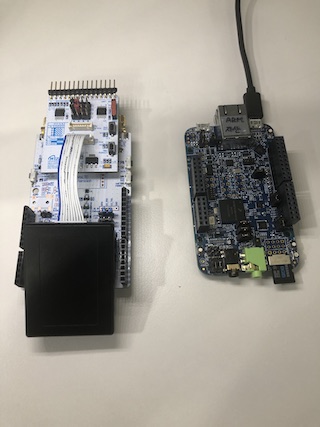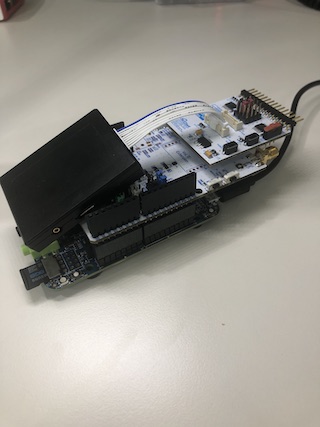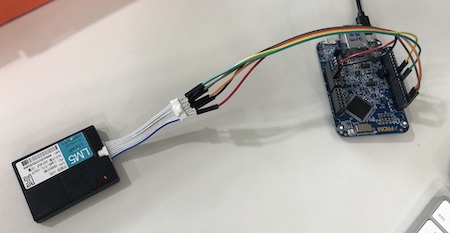K6xF board with BG96 of WIZnet for CatM1 board.
Dependencies: FXAS21002 FXOS8700Q
This document is based on https://os.mbed.com/teams/NXP/code/pelion-example-frdm/
This code could be access via Cat.M1(BG96 module) of SK telecom network in Korea. Need a WIZnet BG96 board or can connect directly to M2Mnet BG96 module and development board.


- FRDM-K64F - onboard Ethernet and onboard SD card holder.
- FRDM-K66F - onboard Ethernet and onboard SD card holder.
-------------------------------


- BG96 RESET = D7
- BG96 PWRKEY = D9
- BG96 TX = D1
- BG96 RX = D0
- BG96 VCC = VCC(5V)
- BG96 GND = GND
Requirement
- FRDM-K64F or FRDM-K66F
- WIZnet BG96 I/F board or M2Mnet BG96 module include SIM card.
Example functionality
This example showcases the following device functionality:
Read onboard FXOS8700Q accelerometer and magnetometer, and report the values as Pelion LWM2M resources (see image below). (FRDM-K66F only) Read onboard FXAS21002 gyroscope and report the values as Pelion LWM2M resources. On user button click, increment Pelion LWM2M button resource. Allow the user to change the state of the board LED from Pelion LWM2M led_state resource and PUT request.
1. Import the application into your desktop:
mbed import http://os.mbed.com/users/Daniel_Lee/code/BG96_K6xF_pelion-example-frdm/ cd BG96_K6xF_pelion-example-frdm
2. Install the CLOUD_SDK_API_KEY
mbed config -G CLOUD_SDK_API_KEY <PELION_DM_API_KEY>
For instructions on how to generate your API key, please see the documentation.
3. Initialize firmware credentials (done once per repository). You can use the following command:
mbed dm init -d "<your company name in Pelion DM>" --model-name "<product model identifier>" -q --force
If the above command does not work for your Mbed CLI, please consider upgrading Mbed CLI to version 1.9.x or above.
4. Compile and program:
mbed compile -t <toolchain> -m <TARGET_BOARD>
(supported toolchains : GCC_ARM / ARM / IAR)
5. If successfully connect to cellular networks(SKTelecom) then you can get below message
[BOOT] Mbed Bootloader [BOOT] ARM: 00000000000000000000 [BOOT] OEM: 00000000000000000000 [BOOT] Layout: 0 83A8 [BOOT] Active firmware integrity check: [BOOT] SHA256: 2DD1793----------------------------------------------------------------- [BOOT] Version: 1563983916 [BOOT] Slot 0 is empty [BOOT] Active firmware up-to-date [BOOT] Application's start address: 0x10400 [BOOT] Application's jump address: 0x10B11 [BOOT] Application's stack address: 0x20030000 [BOOT] Forwarding to application... Starting Simple Pelion Device Management Client example You can hold the user button during boot to format the storage and change the d. M2Mnet(BG96) Power ON Sensors configuration: FXOS8700Q accelerometer = 0xC7 FXOS8700Q magnetometer = 0xC7 Connecting to the network using the default network interface... Connected to the network successfully. IP address: 000:000:000:000:000:000:000:0 Initializing Pelion Device Management Client... Initialized Pelion Device Management Client. Registering... Press the user button to increment the LwM2M resource value... Registered to Pelion Device Management. Endpoint Name: "xx Your Endpoint Name xx" *** Button notification, status Subscribed (6) FXOS8700Q mag: -2.426 x, -0.902 y, -1.611 z [gauss] FXOS8700Q acc: -0.054 x, -0.309 y, 4.306 z [g]
Diff: main.cpp
- Revision:
- 5:f2123dc31d30
- Parent:
- 4:ec3c125c37bf
- Child:
- 11:34e86cb4dd2f
- Child:
- 13:ec1c3a64ee39
--- a/main.cpp Tue Mar 26 13:56:38 2019 +0000
+++ b/main.cpp Wed Mar 27 17:49:40 2019 +0000
@@ -21,6 +21,33 @@
#include "simple-mbed-cloud-client.h"
#include "FATFileSystem.h"
#include "LittleFileSystem.h"
+
+// Default network interface object. Don't forget to change the WiFi SSID/password in mbed_app.json if you're using WiFi.
+NetworkInterface *net = NetworkInterface::get_default_instance();
+
+// Default block device available on the target board
+BlockDevice *bd = BlockDevice::get_default_instance();
+
+#if COMPONENT_SD || COMPONENT_NUSD
+// Use FATFileSystem for SD card type blockdevices
+FATFileSystem fs("fs");
+#else
+// Use LittleFileSystem for non-SD block devices to enable wear leveling and other functions
+LittleFileSystem fs("fs");
+#endif
+
+// Default User button for GET example and for resetting the storage
+InterruptIn button(BUTTON1);
+// Default LED to use for PUT/POST example
+DigitalOut led(LED1, 0);
+
+// How often to fetch sensor data (in seconds)
+#define SENSORS_POLL_INTERVAL 3.0
+
+// Send all sensor data or just limited (useful for when running out of memory)
+//#define SEND_ALL_SENSORS
+
+// Sensors related includes and initialization
#include "FXOS8700Q.h"
#include "FXAS21002.h"
@@ -36,34 +63,12 @@
FXAS21002 sens_gyro(PTD9, PTD8, 0x20);
#endif /* TARGET_K66F */
-#define SENSORS_POLL_INTERVAL 3.0
-#define SEND_ALL_SENSORS
-
-// Default network interface object. Don't forget to change the WiFi SSID/password in mbed_app.json if you're using WiFi.
-NetworkInterface *net = NetworkInterface::get_default_instance();
-
-// Default block device available on the target board
-BlockDevice *bd = BlockDevice::get_default_instance();
-
-#if COMPONENT_SD || COMPONENT_NUSD
-// Use FATFileSystem for SD card type blockdevices
-FATFileSystem fs("fs");
-#else
-// Use LittleFileSystem for non-SD block devices to enable wear leveling and other functions
-LittleFileSystem fs("fs");
-#endif
-
-#if USE_BUTTON == 1
-InterruptIn button(BUTTON1);
-#endif /* USE_BUTTON */
-
-// Default LED to use for PUT/POST example
-DigitalOut led(LED1);
-
// Declaring pointers for access to Pelion Device Management Client resources outside of main()
MbedCloudClientResource *res_button;
MbedCloudClientResource *res_led;
MbedCloudClientResource *res_post;
+
+// Additional resources for sensor readings
#ifdef SEND_ALL_SENSORS
MbedCloudClientResource *res_magnometer_x;
MbedCloudClientResource *res_magnometer_y;
 Daniel Lee
Daniel Lee